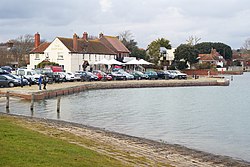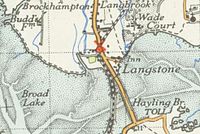Langstone, Hampshire
| Langstone | |
| Hampshire | |
|---|---|
 The Ship Inn, Langstone | |
| Location | |
| Grid reference: | SU721045 |
| Location: | 50°50’10"N, 0°58’39"W |
| Data | |
| Post town: | Havant |
| Postcode: | PO9 |
| Local Government | |
| Council: | Havant |
| Parliamentary constituency: |
Havant |
Langstone is a village on the south coast of Hampshire at the southern edge of Havant, where the bridge stands carrying the A3023 road over to Hayling Island opposite.
The village has good railway connections to London, Southampton, Portsmouth and Brighton, from the nearby Havant railway station. There are many large gated detached houses on the main road, "Langstone Road" and on the roads surrounding this. It has a sailing club, several architecturally unusual buildings, and several historically significant buildings, including a converted (water) millhouse and a converted 18th century windmill, the latter of which is a local landmark.
The village gives its name to Langstone Harbour, the water south of the village between Hayling Island and Portsea Island.
Contents
History
The village used to have rail links with Hayling Island and Havant in the form of the 'Hayling Billy' railway, however the lines have since been torn up and the route replaced with a cycle and bridlepath. The remains of the Hayling Billy rail bridge over to Hayling Island can still be seen.
Streets and bridges
The village surrounds Langstone Road, which crosses the long bridge to Hayling Island. There is a technology park on Langstone Road and this is due to the connections of the road. It lies just off the A27 that provides quick links to Portsmouth, Southampton and Brighton. The A3(M) motorway to London is also nearby.
The Langstone Bridge crosses to Hayling Island: it is a single-carriageway road and footbridge, carrying the A3023; the only road connection from Hayling to the mainland. To the west of the road bridge the remains of the former railway bridge are visible; Langstone Harbour lies to the west of Haying Island and Chichester Harbour to the east.
The historic causeway to Hayling Island known as the Wadeway still exists, however it is now completely impassable, having been cut in two by a deep channel for the Portsmouth and Chichester Canal in the 1820s, the same company having subsequently funded the old wooden road bridge, served by a toll-house situated at the northern end. There was a weight-limit and after WW2 only single-decker buses were allowed across and if they were carrying too many passengers some had to get out and walk, regardless of the weather, to reduce axle-weight. The old wooden bridge was demolished following construction of the current (2014) concrete bridge in the late 1950s. The much earlier causeway was known as the wade way, and was classified as a bridleway in 1988, and is shown as such on modern Ordnance Survey maps in spite of its use being considered hazardous at best. Excavation of this feature in 2006, constructed on a natural high point in the harbour, put its date in the Roman to mediæval range but found no evidence to be more specific.[1]
About the village
The village High Street is designated as a Conservation Area. The coastal path leading eastwards from the village is both part of the Solent Way and the Wayfarers Walk.
Thorney Island and Portsea Island are also both clearly visible from the village coast.
There are two pubs In Langstone:
- The Royal Oak
- The Ship Inn
Architecture
Flooding can be a problem in the village, on occasion with water right up to the main Langstone Road, and many buildings on Langstone High Street have slots for wooden barriers on their door frames, and stack up sandbags. However flood risk to buildings is strictly limited to the older (pre-twentieth century) properties.
Houses in the terrace on Langstone High Street date back to the 18th century and a number are thatched. The other significant buildings, commonly featured in local postcards, is Langstone Towers, characterised by a large lightning conductor.
Outside links
| ("Wikimedia Commons" has material about Langstone, Hampshire) |
References
- ↑ Chichester Harbour Conservancy "Changing Landscapes" project website "Accessed 25 Nov 2009" Citing unpublished reports by Maritime Archaeology Ltd, 2005, 2006, 2007 Chichester Wadeway Investigation Phases 1, 2, 3 respectively.


